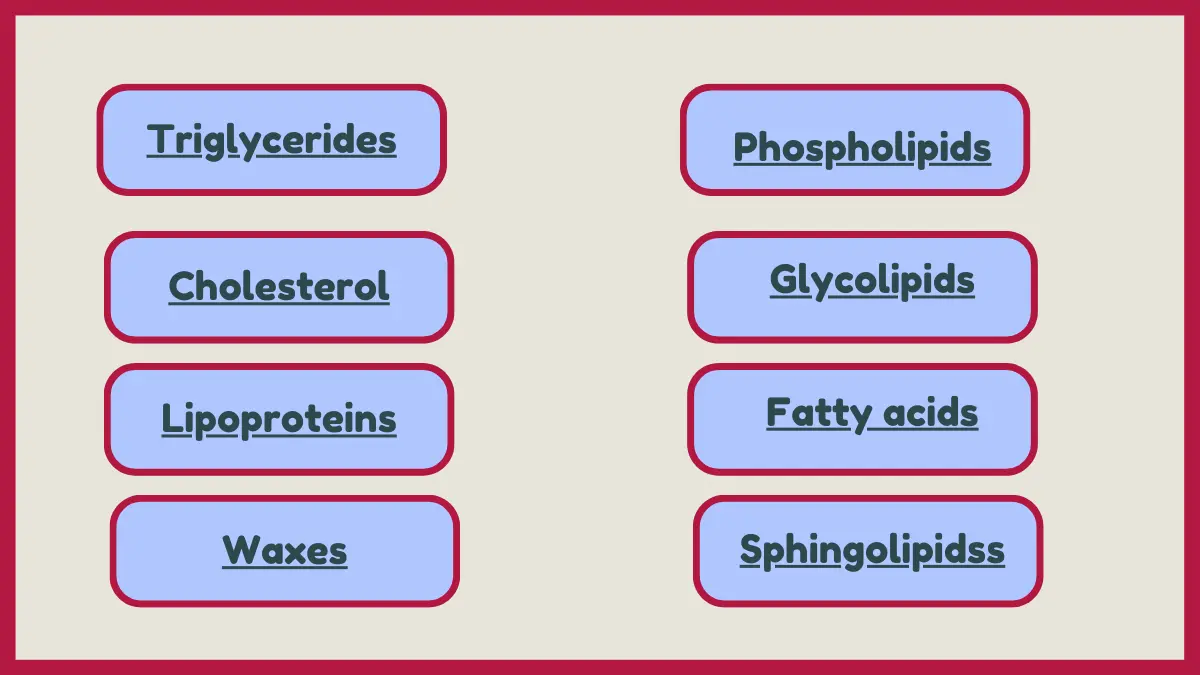Lipids are a broad group of hydrophobic molecules that serve many important biological functions. The main examples of lipids include fats, oils, waxes, sterols like cholesterol, and phospholipids that makeup cell membranes.

Examples of Lipids
Here are some important examples of lipids:
1. Triglycerides
Triglycerides are an example of lipids, that consist of three fatty acids. These fatty acids are linked to a glycerol backbone that makes up body fat and serves as an important reservoir of metabolic energy. They provide insulation and padding as well. Triglycerides yield more than twice as much energy per unit mass as carbohydrates when broken down.
2. Phospholipids
Phospholipids are another important example of lipids. It is a major component of cell membranes and organelle membranes. Their amphipathic structure with a hydrophobic tail region and hydrophilic phosphate-containing head group allows them to form bilayers spontaneously. This provides the basic barrier structure of membranes.
3. Cholesterol
Cholesterol is an essential lipid molecule inserted into animal cell membranes where it helps modulate membrane fluidity and permeability. Cholesterol serves as the starting compound for the biosynthesis of vitamin D, bile acids to digest fats, and steroid hormones like estrogen and testosterone.
4. Glycolipids
Glycolipids are lipids that contain carbohydrate residues. They extend from the outer surface of cell membranes and play important roles in cell recognition, communication, and maintaining membrane structure. Glycolipids are especially abundant in neural tissue.
5. Lipoproteins
Lipoproteins are conjugated molecules of lipids and proteins. It allows hydrophobic lipids like cholesterol to be transported through the aqueous environment of the bloodstream. They contain an outer phospholipid layer, apolipoproteins, and a core containing triglycerides and cholesterol esters. Different lipoproteins transport lipids to and from tissues.
6. Fatty acids
Fatty acids like palmitic, stearic, and oleic acid are the key components of more complex lipids like triglycerides and phospholipids. Essential fatty acids must come from the diet. Fatty acids undergo beta-oxidation to release energy from their carbon chains.
7. Waxes
Waxes made up of fatty acids or alcohols bonded to long-chain hydrocarbons provide protective coatings on plant cuticles, feather shafts in birds, hair in mammals, and the exoskeleton of insects. This prevents desiccation.
8. Sphingolipids
Sphingolipids are a class of lipids derived from the aliphatic amino alcohol sphingosine rather than glycerol. They are found in cell membranes and play signaling roles vital for cell growth, death, and differentiation. Myelin sheaths containing sphingolipids insulate nerve cells.
9. Sterols
Sterols have a four-ring steroid nucleus. Cholesterol is the sterol found in animal cell membranes while phytosterols occur in plant membranes. Sterols help control membrane fluidity and permeability. Cholesterol is also the precursor of steroid hormones.
10. Leukotrienes
Leukotrienes are signaling lipids synthesized from arachidonic acid that promote inflammation. They play important roles in the body’s immune response, regulating mechanisms like increased vascular permeability during an inflammatory response.
11. Prostaglandins
Related to leukotrienes, prostaglandins are hormone-like lipids synthesized from arachidonic acid that bind receptors at low concentrations. They help regulate blood pressure, ovulation, nerve sensitivity, blood clotting, and inflammation.
12. Liposomes
Liposomes are spherical vesicles composed of phospholipid bilayers. They can encapsulate and deliver hydrophobic drug molecules, enzymes, or genetic material into cells when the liposomal and cellular membranes fuse together.
13. Triacylglycerol
Triacylglycerol (triglyceride) is composed of three fatty acids each attached to a glycerol molecule. This lipid stores excess energy from carbohydrates and provides insulation and padding in adipose tissue.
14. Cerebrosides
Cerebrosides are glycolipids containing a fatty acid, sphingosine, and a sugar like glucose or galactose. They are found primarily in neural tissue and are abundant components of myelin, the insulation surrounding nerve axons.
15. Gangliosides
Related cerebrosides, gangliosides have complex, branched oligosaccharide chains containing sialic acid. They are also concentrated in grey matter and play important roles in neurodevelopment, nerve transmission, and cell signaling.
16. Lipase
Lipase is an enzyme that catalyzes the breakdown of triglycerides into glycerol and fatty acids. It is essential for efficient digestion and absorption of lipids from the diet by hydrolyzing triglycerides into more polar molecules.

